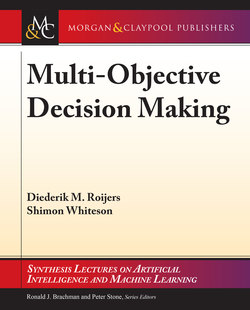Читать книгу Multi-Objective Decision Making - Diederik M. Roijers - Страница 8
ОглавлениеPreface
Many real-world decision problems have multiple, possibly conflicting, objectives. For example, an autonomous vehicle typically wants to minimize both travel time and fuel costs, while maximizing safety; when seeking medical treatment, we want to maximize the probability of being cured, but minimize the severity of the side-effects, etcetera.
Although interest in multi-objective decision making has grown in recent years, the majority of decision-theoretic research still assumes only a single objective. In this book, we argue that multi-objective methods are underrepresented and present three scenarios to justify the need for explicitly multi-objective approaches. Key to these scenarios is that, although the utility the user derives from a policy—which is what we ultimately aim to optimize—is scalar, it is sometimes impossible, undesirable, or infeasible to formulate the problem as single-objective at the moment when the policies need to be planned or learned. We also present the case for a utility-based view of multi-objective decision making, i.e., that the appropriate multi-objective solution concept should be derived from what we know about the user’s utility function.
This book is based on our research activities over the years. In particular, the survey we wrote together with Peter Vamplew and Richard Dazeley [Roijers et al., 2013a] forms the basis of how we organize concepts in multi-objective decision making. Furthermore, we use insights from our work on multi-objective planning over the years, particularly in the context of the PhD research of the first author [Roijers, 2016]. Another important source for writing this book were the lectures we gave on the topic at the University of Amsterdam, and the tutorials we did at the IJCAI-2015 and ICAPS-2016 conferences, as well as the EASSS-2016 summer school.
Aim and Readership This book aims to provide a structured introduction to the field of multi-objective decision making, and to make the differences with single-objective decision theory clear. We hope that, after reading this book, the reader will be equipped to conduct research in multi-objective decision-theory or apply multi-objective methods in practice.
We expect our readers to have a basic understanding of decision theory, at a graduate or undergraduate level. In order to remain accessible to a wide range of readers, we provide intuitive explanations and examples of key concepts before formalizing them. In some cases, we omit detailed proofs of theorems in order to better focus on the intuition behind and implications of these theorems. In such cases, we provide references to the detailed proofs.
Outline This book is structured as follows. In Chapter 1, we motivate multi-objective decision making by providing examples of multi-objective decision problems and scenarios that require explicitly multi-objective solution methods. In Chapter 2, we introduce two popular classes of decision problems that we use throughout the book to illustrate specific algorithms and general theoretical results. In Chapter 3, we present a taxonomy of solution concepts for multi-objective decision problems. Using this taxonomy, we discuss different solution methods. First, we assume that the model of the environment is known to the agents, leading to a planning setting. In Chapters 4 and 5, we discuss two different approaches for finding a coverage set using planning algorithms. In Chapter 6, we remove the assumption that the agents are given a model of the environment, and consider cases where they must learn about the environment through interaction. Finally, we discuss several illustrating applications in Chapter 6, followed by conclusions and future work in Chapter 8.
Diederik M. Roijers and Shimon Whiteson
April 2017
